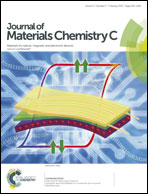Multifunctional terpyridine/diphenylamine derivatives as highly efficient blue fluorescent emitters and red phosphorescent hosts†
Abstract
Three terpyridine (TPY)/diphenylamine (DPA) derivatives, with DPA functioning as the electron donor and TPY as the electron acceptor, were designed and synthesized. By switching the position of the nitrogen atom in the substituted pyridine of TPY acceptors, we can adjust the electron-drawing strength of the TPY group, and hence, further modify the fluorescence, lowest unoccupied molecular orbital energy levels, carrier transporting properties of three compounds, but barely influence triplet energy levels. Three compounds satisfy the requirements of multifunctional blue fluorophores and are successfully used as highly efficient blue fluorescent emitters and red phosphorescent hosts in organic light-emitting devices (OLEDs). Non-doped blue fluorescent OLEDs that use TPY22DPA, TPY33DPA, and TPY44DPA as emitters exhibit maximum external quantum efficiencies (EQEs) of 4.9%, 3.8%, and 2.7%, respectively. Meanwhile, red phosphorescent OLEDs that use TPY22DPA, TPY33DPA, and TPY44DPA as host materials exhibit maximum EQEs of 19.1%, 20.9%, and 17.2%, respectively. These results are among the best reported multifunctional blue fluorophore efficiencies.


 Please wait while we load your content...
Please wait while we load your content...